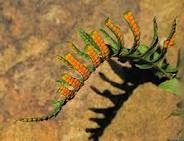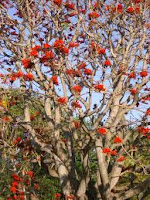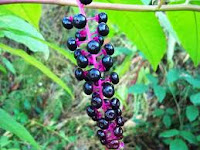Arrowleaf dock is called khatti buti in Urdu which means sour wheat. It is a member of the Polygonaceae or buckwheat family of plants and related to Yellow dock, Common dock, Red dock, sorrel and rhubarb. The Arrowleaf dock is native to the Indian subcontinent and is used both as a vegetable, like spinach, in saag dishes, although the water is changed several times during the cooking process as the older leaves are bitter. The leaf is used in chutneys and pickles as well as to flavour some dishes.
Arrowleaf dock is also used in traditional medicine systems to treat a number of ailments. One treatment is ½ a kilo of the fresh roots and 250 grams of the bark of an oak tree (Quercus incana) boiled for one or two hours in 4 litres of water until only a litre of liquid is left. The liquid is then filtred and 250 grams of sugar and one kilo of sooji (semolina a wheat product) flour, 250 grams of desi ghee (fat) are added to it and this is cooked for ten to fifteen minutes to make halwa. It is given to people with asthma, coughs or fever.
 This plant can grow up to about 2 feet tall and has pink flowers which bloom throughout March to August. The fruit is also pink and has a one seed. Its leaves are edible and are also used as fodder. It is found in
This plant can grow up to about 2 feet tall and has pink flowers which bloom throughout March to August. The fruit is also pink and has a one seed. Its leaves are edible and are also used as fodder. It is found in In traditional medicine the leaves and young shoots are said to be diuretic, and cooling. Its roots are used in Ayurvedic medicine and other folk medicine systems for rheumatoid arthritis, diarrhoea and dysentery, for wound healing and jaundice among other ailments. The juice of the plant is used to lower and regulate blood pressure and the leaves have laxative properties as well as being used for upset stomachs and bilious attacks, skin diseases, piles and bleeding of the lungs. They are also made into a general tonic for weak animals. The fresh tuber is chewed to relieve a sore throat, and it is believed that this plant is good to treat STDs including the HIV/AIDS.
Arrowleaf dock has been the subject of several clinical trials and has been found to be effective in the treatment of diarrhoea in lab rats (“Evaluation of Antioxidant activity of extract from roots of Rumex hastatus (Family: Polygonaceae) on experimental animals” Shakuntala et al., Journal of Applied Pharmaceutical Science 1 (6): 2011 pp. 182-5).
In the Journal of Medicinal Plants Research Vol. 5 (13) pp 2755-2765, Sumaira Sahreen et al July 2011, “Phenolic Compounds and antioxidant activities of Rumex hastatus D. Don. Leaves” found Rumex hastatus leaves “can be used as a good source of potential antioxidant or functional food material due to the presence of sufficient amounts of phenolic such as luteolin and kaempferol.”
The plant has bioflavonoids and phenolic compounds which need further screening to discover just how beneficial they can be for us and our health. The studies have so far centred on the traditional uses of this plant and have tried to identify the substances which are responsible for its reported actions.


















































